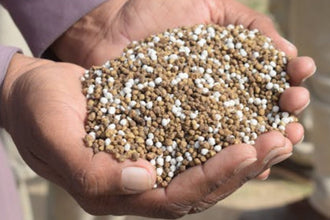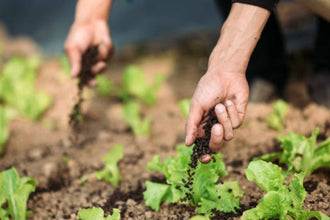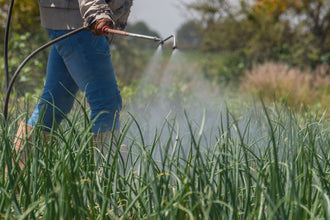
A fertilizer calculator takes the guesswork out of feeding your plants and lawn. Most gardeners either dump way too much on their soil or use barely enough, completely missing that sweet spot where plants actually thrive. Getting the right amount makes a huge difference between a garden that barely survives and one that makes your neighbors jealous.
You probably think more fertilizer means better results. Most people do. This mistake leads to burned plants, wasted cash, and a mess for the environment. Learning how to calculate exactly what your garden needs saves you from these headaches and gives your plants exactly what they're craving to grow strong.
Understanding Your Garden's Fertilizer Needs
Every garden is different. Your soil, plants, and growing conditions create unique needs that a fertilizer calculator helps you figure out. What works amazing for your neighbor's tomatoes might kill your roses. Different plants want different nutrients, and timing matters more than most people realize.
Your soil probably has some natural fertility left, but years of growing plants sucks those nutrients right out. You can keep adding chemical fertilizers for quick fixes, but that's like putting a band-aid on a bigger problem. Organic fertilizers work slower but actually build up your soil for the long run.
What Makes Plants Need More or Less Fertilizer
Your plants tell you what they need if you know how to look. Leafy stuff like lettuce and spinach goes crazy for nitrogen. Flowers need phosphorus to actually bloom. Root vegetables like carrots want potassium to develop those thick, sweet roots we all want.
Your soil type changes everything too. Clay soil holds onto nutrients but releases them super slowly. Sandy soil drains fast and you'll need to feed more often. If you've been adding compost or other organic matter, your soil acts like a sponge that holds nutrients and feeds them to plants gradually.
Weather messes with your fertilizer plans more than you'd think:
-
Hot, dry spells slow down plant growth and they can't use nutrients as fast
-
Heavy rain washes nutrients away before plants grab them
-
Cool weather means plants grow slower and need less food
-
Windy conditions dry out soil faster and change how nutrients move around
Making Sense of Those NPK Numbers
Every fertilizer bag shows three numbers like 10-10-10 or 5-2-3. These tell you the percentage of nitrogen (N), phosphorus (P), and potassium (K) inside. Higher numbers mean stronger stuff that you don't need as much of.
Nitrogen is the green machine. It makes leaves dark and lush. Too much creates weak, floppy growth that bugs love to attack. Too little gives you yellow, sad-looking plants.
Phosphorus helps roots grow strong and flowers show up. Most soil already has plenty, so you probably don't need fertilizers loaded with phosphorus unless a soil test says otherwise.
Potassium is like vitamins for plants. It helps them handle stress, fight off diseases, and survive cold snaps. You'll see brown edges on leaves when plants don't get enough.
How to Use a Fertilizer Calculator
Start by measuring your space correctly. Length times width gives you square feet for basic rectangular areas. Got a weird-shaped garden? Break it into smaller chunks and add them up. Knowing exactly how much space you're working with stops you from buying too much or too little.
Pick the right fertilizer for what you're growing and your soil situation. Granular types work great for lawns and big garden beds. Liquid fertilizers give quick nutrition to potted plants and seedlings. Organic options feed slowly and actually improve your soil as they work.
Getting the Math Right
Most fertilizer calculators need three things from you: how big your area is, what nutrient levels you want, and what's in your fertilizer. The calculator does the hard math and tells you exactly how much to spread around.
Here's how it works in real life. Say you want 1 pound of nitrogen per 1,000 square feet using 10-10-10 fertilizer. You need 10 pounds of the stuff because 10% of 10 pounds equals that 1 pound of actual nitrogen you're after.
Different ways of putting fertilizer down need different amounts:
-
Broadcasting spreads it evenly everywhere
-
Banding puts fertilizer in rows near plant roots
-
Side-dressing adds food around plants that are already growing
Converting All Those Confusing Units
Fertilizer recommendations come in all kinds of measurements that can drive you nuts. Pounds per acre, pounds per 1,000 square feet, ounces per square yard. They're all measuring the same thing but differently. Good calculators convert these automatically so you don't have to.
One acre equals 43,560 square feet. If someone says use 50 pounds per acre, you need about 1.15 pounds per 1,000 square feet. Breaking big numbers into smaller ones makes the whole thing way less overwhelming.
Container plants need their own math. Potting soil doesn't hold nutrients like garden soil does, so container plants get hungry faster. Calculate based on how much soil is in your pots, not just the surface area.
Different Fertilizer Calculator Methods
You've got several ways to figure out fertilizer needs, and each works better for different situations. The percentage method uses those NPK numbers directly and works great for home gardens. Professional growers use parts per million calculations for super precise control.
Weight-based calculations tell you pounds or ounces per area. Volume-based ones work better for liquid fertilizers measured in gallons. Some calculators do both to give you complete instructions.
Doing the Math by Hand
You can calculate fertilizer needs without any fancy tools using basic math. Multiply your garden area by how much you're supposed to apply per square foot. Then divide by the fertilizer percentage to find out how much product to buy.
Got a 500-square-foot garden that needs 1 pound of nitrogen per 1,000 square feet? You need 0.5 pounds of actual nitrogen. Using fertilizer that's 20% nitrogen, divide 0.5 by 0.20 to get 2.5 pounds of product.
Make yourself a simple chart with your garden areas and what they need each season. Update it every year based on how your plants did. This saves time and prevents mistakes when you're rushing to get everything planted.
Digital Tools That Make Life Easier
Modern fertilizer calculator apps make this whole process way simpler. Type in your garden size, pick your plants, choose your fertilizer, and boom. The app tells you exactly how much to use and often when to apply it.
Many state universities offer free online calculators made for local growing conditions. These account for your area's climate, soil types, and what plants grow well there. Using local tools gives better results than generic calculators.
Smartphone apps often include extra features like tracking what you've applied, reminders for the next feeding, and cost comparisons between different fertilizers. Some even connect to weather data to suggest the best application timing.
Timing Your Fertilizer Applications
Plants need different nutrients as they grow. Baby seedlings want gentle, balanced food to get their roots and first leaves going. Mature plants getting ready to produce fruit do better with less nitrogen and more potassium for stronger development.

Spring feeding wakes plants up after winter. Fall applications help them store energy for cold weather survival. Summer feeding keeps them going during peak growing season.
When to Feed Throughout the Year
Start spring feeding when soil hits 55°F consistently. This changes depending on where you live but usually happens when those yellow forsythia bushes start blooming. Start too early and you're just wasting fertilizer because plants can't use nutrients in cold soil.
Mid-season applications keep plants happy during their busiest growth time:
-
Vegetables need side-dressing when they start flowering or setting fruit
-
Perennial flowers appreciate feeding after their first big spring growth spurt
-
Shrubs and trees benefit from feeding before their major growth period
Late-season feeding gets plants ready for winter and next year's growth. Stop nitrogen feeding 6-8 weeks before your first expected frost. Late nitrogen creates tender new growth that winter kills. You can keep applying potassium later since it actually helps plants handle cold better.
Common Calculation Mistakes
Over-fertilizing is the biggest and most expensive mistake gardeners make. More fertilizer doesn't create better plants. Too much burns roots, attracts diseases, and pollutes groundwater. Sticking to calculated recommendations prevents all these problems.
Under-fertilizing also hurts plant performance but doesn't cause immediate damage. Plants grow slowly, produce fewer flowers or vegetables, and look pale. These problems develop gradually and you might not notice until significant damage happens.
Ignoring soil pH messes up everything regardless of how much fertilizer you use. Most nutrients become unavailable in very acidic or very alkaline soils. Test and fix pH before calculating fertilizer needs.
Measurement and Application Problems
Guessing at fertilizer amounts leads to uneven results. Some spots get way too much while others get nothing. Buy a scale for accurate measuring and a spreader for even distribution. Your plants will thank you.
Mixing different fertilizers without recalculating can create dangerous concentrations. Stick to one product per application or use a calculator to figure out combined nutrient levels from multiple sources.
Never apply fertilizer to bone-dry soil or during blazing hot weather. This increases burn risk big time. Water lightly before application and thoroughly afterward for granular products. Apply liquid fertilizers during cooler parts of the day.
Building Long-Term Soil Health
Smart gardening focuses on building healthy soil instead of just adding synthetic nutrients. Healthy soil contains millions of helpful microorganisms that help plants absorb nutrients better. These tiny soil creatures also protect plants from diseases and pests.
Organic matter feeds soil microbes and improves soil structure. Compost, aged manure, and leaf mold add nutrients slowly while creating better growing conditions. A fertilizer calculator helps you balance organic and synthetic inputs for the best plant nutrition.
Cover crops grown during off-seasons add organic matter and actually pull nitrogen from the air into your soil. Plants like crimson clover can provide significant nitrogen for next year's crops, cutting down your fertilizer needs.
Reducing Future Fertilizer Requirements
Well-managed soil needs less fertilizer over time as organic matter builds up and beneficial microorganisms multiply. Start with calculated applications based on soil tests, then gradually reduce amounts as your soil gets healthier.
Mulching around plants saves moisture and slowly releases nutrients as organic mulches break down. This natural process supplements fertilizer applications and makes them last longer.
Choose the right plants for your conditions and you'll need way less fertilizer. Native plants adapted to your area typically need minimal extra feeding. Picking varieties that match your soil type and climate creates lower-maintenance gardens that still look amazing.
Why Fancy Chicken Organic Fertilizer Simplifies Your Calculations
Perfect NPK Balance Made Simple
Fancy Chicken takes the complexity out of fertilizer calculations with its balanced 4-2.5-2 NPK formula. This thoughtfully crafted ratio means you don't need to juggle multiple products or worry about mixing different nutrient sources. The moderate nitrogen content promotes steady, healthy growth without the explosive spurts that weaken plants and attract pests.
The phosphorus level supports strong root development and flower production without overloading your soil with this often-abundant nutrient. The potassium content helps your plants build natural resistance to diseases and weather stress. When you use a fertilizer calculator with Fancy Chicken, you're working with a formula designed to deliver consistent results across different plant types.
Slow-Release Benefits Your Budget and Plants
Unlike synthetic fertilizers that dump all their nutrients at once, Fancy Chicken's organic pelletized chicken manure releases nutrients gradually over months. This slow-release action means your fertilizer calculator needs show smaller, less frequent applications compared to quick-release synthetic options.
Your plants get steady nutrition without the feast-or-famine cycle that stresses root systems. The gradual nutrient release also means less runoff during heavy rains, so more of what you pay for actually feeds your plants instead of washing away.
The organic matter in Fancy Chicken improves soil structure as it breaks down, creating better conditions for nutrient uptake. Your future fertilizer calculations will show reduced needs as your soil builds natural fertility over time.
Calculator-Friendly Application Rates
Fancy Chicken's consistent pellet size makes accurate measuring and spreading straightforward. Most fertilizer calculators recommend 2-4 pounds per 100 square feet for general garden use, but you can adjust based on specific plant needs and soil conditions.
Application becomes even simpler with these guidelines:
-
Vegetable gardens: Apply every 6-8 weeks during growing season
-
Flower beds: Feed at planting and mid-season
-
Lawns: Two applications per year, spring and fall
-
Container plants: Mix into potting soil at planting time
Versatile Formula for All Your Garden Areas
One bag of Fancy Chicken handles your entire property, from vegetable plots to flower borders to lawn areas. This versatility simplifies your fertilizer calculations because you're working with one consistent product instead of multiple specialty formulas.
The balanced nutrition works well for acid-loving plants like blueberries and alkaline-preferring vegetables like asparagus. New seedlings get gentle nutrition while established plants receive adequate feeding for peak performance.
Building Soil Means Fewer Future Applications
Fancy Chicken does more than feed plants - it actually improves your growing medium. The organic matter feeds beneficial soil microorganisms that help plants access nutrients more efficiently. Over time, your fertilizer calculator will show you need smaller amounts as your soil develops natural fertility.
The microbial activity Fancy Chicken stimulates also helps break down organic matter already in your soil, releasing additional nutrients your plants can use. This natural process reduces your dependence on purchased fertilizers while creating healthier, more productive growing conditions.
Get Your Garden Growing Right
Stop guessing at fertilizer amounts and start seeing real results in your garden. A fertilizer calculator paired with Fancy Chicken's proven organic formula gives you the confidence to feed your plants exactly what they need without waste or worry.
Your soil gets healthier with every application while your plants show the vigorous growth that comes from proper nutrition. Calculate your needs, apply with confidence, and watch your garden transform into the productive space you've always wanted.
Transform Your Garden with Smart Fertilizing
Understanding exactly how much fertilizer your garden needs takes all the guesswork out of plant care. A fertilizer calculator gives you confidence to feed your plants properly without waste or environmental problems. Start with accurate measurements, choose the right products, and follow calculated recommendations.
Your garden will reward you with stronger growth, better harvests, and plants that can actually fight off pests and diseases. Take time to calculate your fertilizer needs correctly instead of just winging it. Your plants will show you the difference with growth that makes all that math worth the effort.








